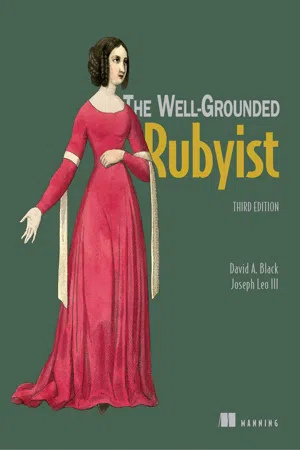
- 584 pages
- English
- ePUB (mobile friendly)
- Available on iOS & Android
The Well-Grounded Rubyist
About this book
Summary The Well-Grounded Rubyist, Third Edition is a beautifully written tutorial that begins with your first Ruby program and takes you all the way to sophisticated topics like reflection, threading, and recursion. Ruby masters David A. Black and Joe Leo distill their years of knowledge for you, concentrating on the language and its uses so you can use Ruby in any way you choose. Updated for Ruby 2.5.Purchase of the print book includes a free eBook in PDF, Kindle, and ePub formats from Manning Publications. About the Technology Designed for developer productivity, Ruby is an easy-to-learn dynamic language perfect for creating virtually any kind of software. Its famously friendly development community, countless libraries, and amazing tools, like the Rails framework, have established it as the language of choice for high-profile companies, including GitHub, SlideShare, and Shopify. The future is bright for the well-grounded Rubyist! About the Book In The Well-Grounded Rubyist, Third Edition, expert authors David A. Black and Joseph Leo deliver Ruby mastery in an easy-to-read, casual style. You'll lock in core principles as you write your first Ruby programs. Then, you'll progressively build up to topics like reflection, threading, and recursion, cementing your knowledge with high-value exercises to practice your skills along the way. What's Inside
- Basic Ruby syntax
- Running Ruby extensions
- FP concepts like currying, side-effect-free code, and recursion
- Ruby 2.5 updates
About the Reader For readers with beginner-level programming skills. About the Authors David A. Black is an internationally known Ruby developer and author, and a cofounder of Ruby Central. Ruby teacher and advocate Joseph Leo III is the founder of Def Method and lead organizer of the Gotham Ruby Conference. Table of Contents
PART 1 RUBY FOUNDATIONS
- Bootstrapping your Ruby literacy
- Objects, methods, and local variables
- Organizing objects with classes
- Modules and program organization
- The default object (self), scope, and visibility
- Control-flow techniques
PART 2 BUILT-IN CLASSES AND MODULES
- Built-in essentials
- Strings, symbols, and other scalar objects
- Collection and container objects
- Collections central: Enumerable and Enumerator
- Regular expressions and regexp-based string operations
- File and I/O operations
PART 3 RUBY DYNAMICS
- Object individuation
- Callable and runnable objects
- Callbacks, hooks, and runtime introspection
- Ruby and functional programming
Frequently asked questions
- Essential is ideal for learners and professionals who enjoy exploring a wide range of subjects. Access the Essential Library with 800,000+ trusted titles and best-sellers across business, personal growth, and the humanities. Includes unlimited reading time and Standard Read Aloud voice.
- Complete: Perfect for advanced learners and researchers needing full, unrestricted access. Unlock 1.4M+ books across hundreds of subjects, including academic and specialized titles. The Complete Plan also includes advanced features like Premium Read Aloud and Research Assistant.
Please note we cannot support devices running on iOS 13 and Android 7 or earlier. Learn more about using the app.
Information
Part 1. Ruby foundations
Chapter 1. Bootstrapping your Ruby literacy
- A Ruby syntax survival kit
- Writing, saving, running, and error-checking programs
- A tour of the Ruby installation
- The mechanics of Ruby extensions
- Ruby’s command-line tools such as irb and rake
- Core language: design principles, syntax, and semantics
- Extensions and libraries that ship with Ruby, and the facilities for adding extensions of your own
- Command-line tools that come with Ruby, with which you run the interpreter and some other important utilities
1.1. Basic Ruby language literacy
1.1.1. Installing Ruby and using a text editor
>> 100 + 32 => 132
irb --simple-prompt
Table of contents
- Copyright
- Brief Table of Contents
- Table of Contents
- Praise for the Second Edition
- Preface
- Acknowledgments
- About this book
- About the authors
- About the cover illustration
- Part 1. Ruby foundations
- Part 2. Built-in classes and modules
- Part 3. Ruby dynamics
- Index
- List of Figures
- List of Tables
- List of Listings